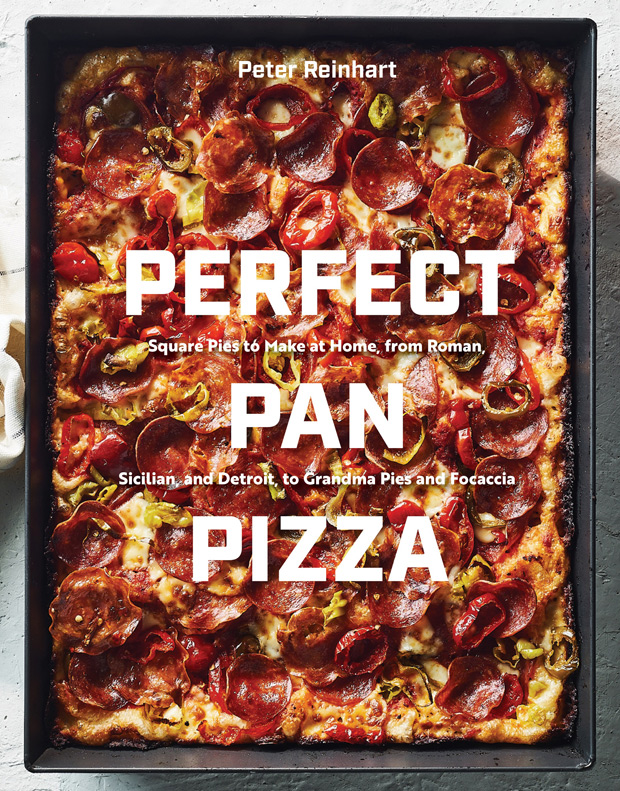Recipe
April 25, 2019
Pesto Genovese

Try this Pesto Genovese recipe from the cookbook Perfect Pan Pizza by Peter Reinhart.
 When I first discovered pesto about forty years ago, I thought that I had gone to heaven. Pesto was so new and different to Americans then. Sadly, we’ve now become too familiar with it, and it has been overused in so many ways that now it runs the risk of being a culinary cliché. However, during my travels through Liguria and Genoa, where pesto has been a staple for centuries, I found that nobody seemed to have tired of it. All it took was one dinner there, and my passion for pesto was reborn.
When I first discovered pesto about forty years ago, I thought that I had gone to heaven. Pesto was so new and different to Americans then. Sadly, we’ve now become too familiar with it, and it has been overused in so many ways that now it runs the risk of being a culinary cliché. However, during my travels through Liguria and Genoa, where pesto has been a staple for centuries, I found that nobody seemed to have tired of it. All it took was one dinner there, and my passion for pesto was reborn.
Here in the States, the problem with much of the pesto is its lack of what I would call brightness. Nowadays, a lot of restaurant pesto is a dull green, thick and pasty, the flavors locked up, trapped in the cheese. Back in the 1970s, pesto was too new to be taken for granted. I tried it for the first time in San Francisco, at Tony La Tona’s legendary Caffe Sport. His pesto was bright green, and the basil flavor exploded in my mouth, carried home by the cheese and pine nut base notes. It changed my life.
It had been a long time since pesto had sent me into such ecstasy, but when it was served to me over some toothsome, house-made troffie pasta at da Vittorio in the Ligurian seaside town of Recco, I felt as though time had compressed and I was discovering it anew, just like my first time at Caffe Sport.
I came up with the following recipe to channel those great taste memories. This pesto is smooth and creamy and very spreadable, not thick and pasty. You can use all pine nuts or all walnuts, whichever you prefer or have on hand. If you like to experiment, try a combination of the two. The sauce can be added to a focaccia or pizza just before it goes into the oven or drizzled over it after it comes out.
Directions
Yield: Makes 2 cups
- In a dry skillet, lightly toast the nuts over medium heat until they just begin to release their aroma and show signs of browning, 3 to 5 minutes. Immediately transfer them to a bowl and set aside.
- In the same skillet, heat the oil over medium-high heat. When the oil is very hot but not smoking, turn off the heat, add the chopped garlic, and stir for about 5 seconds. (The garlic does not need to be browned; the quick cooking is merely to take away the “burn” from the garlic and release its flavor.) Immediately transfer the oil and garlic to an empty bowl and set aside.
- Combine the basil, the garlic with oil, the 1 cup of extra-virgin olive oil, half of the toasted nuts, the lemon juice and 1⁄2 cup of the grated cheese in the bowl of a food processor fitted with the metal blade attachment (or in a high-powered blender). Process the ingredients until smooth, adding more oil if needed, and transfer the mixture to a bowl. It should be runny and thin, not thick and stiff.
- Slowly fold in the remaining pine nuts and the remaining 1⁄2 cup of cheese, stopping before the pesto becomes too thick; it should be thin enough to drizzle. If it is too thick, whisk in a little more oil; if too thin, add more grated cheese. Taste the pesto. If it is undersalted (it probably won’t be), add either some salt or a little more cheese.
- Transfer the pesto to an airtight container, seal tightly and store in the refrigerator for about 1 week. Be aware that it will begin to lose some of its bright color the longer it sits.
Excerpted from Perfect Pan Pizza: Square Pies to Make at Home from Roman, Sicilian, and Detroit, to Grandma Pies and Focaccia by Peter Reinhart. Copyright © 2019 by Peter Reinhart. Photographs copyright © 2019 by Johnny Autry. Published in the United States by Ten Speed Press, an imprint of the Crown Publishing Group, a division of Penguin Random House LLC, New York. Reproduced by arrangement with the Publisher. All rights reserved.

